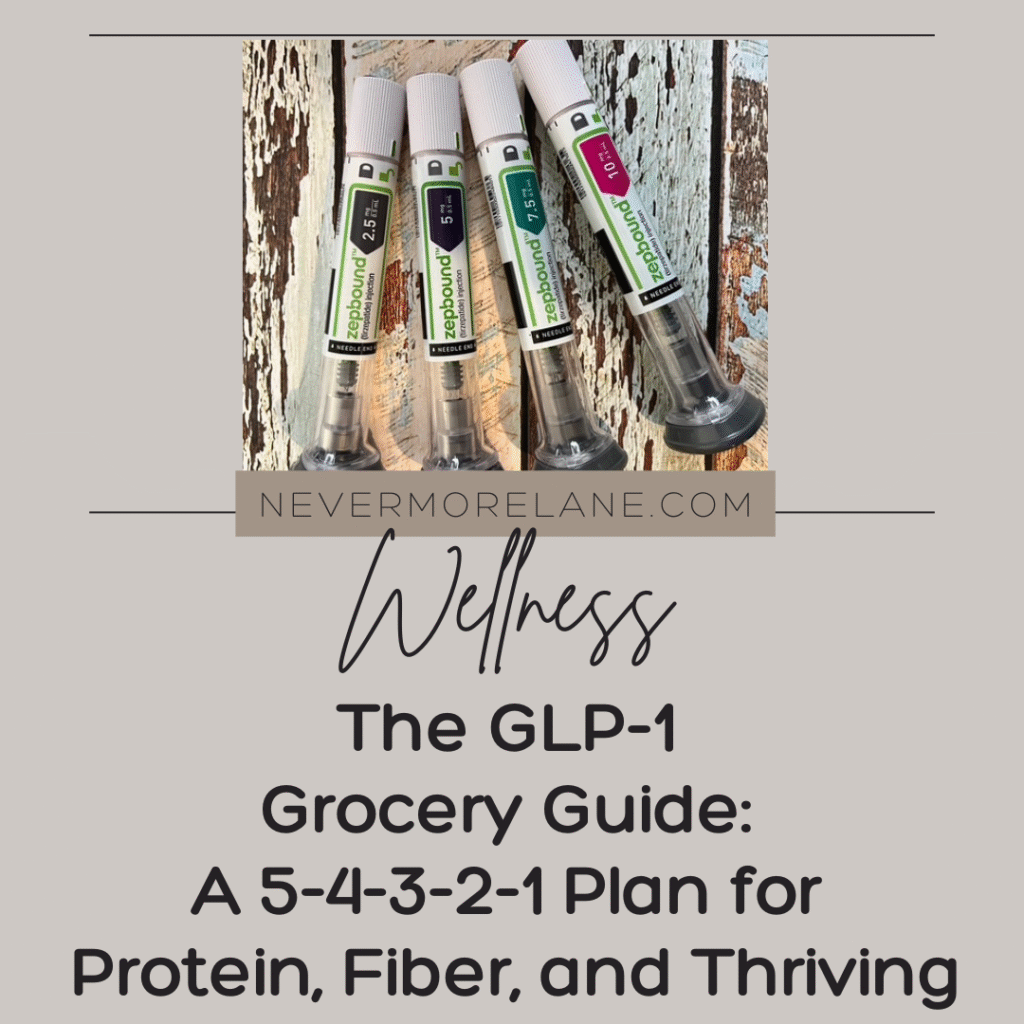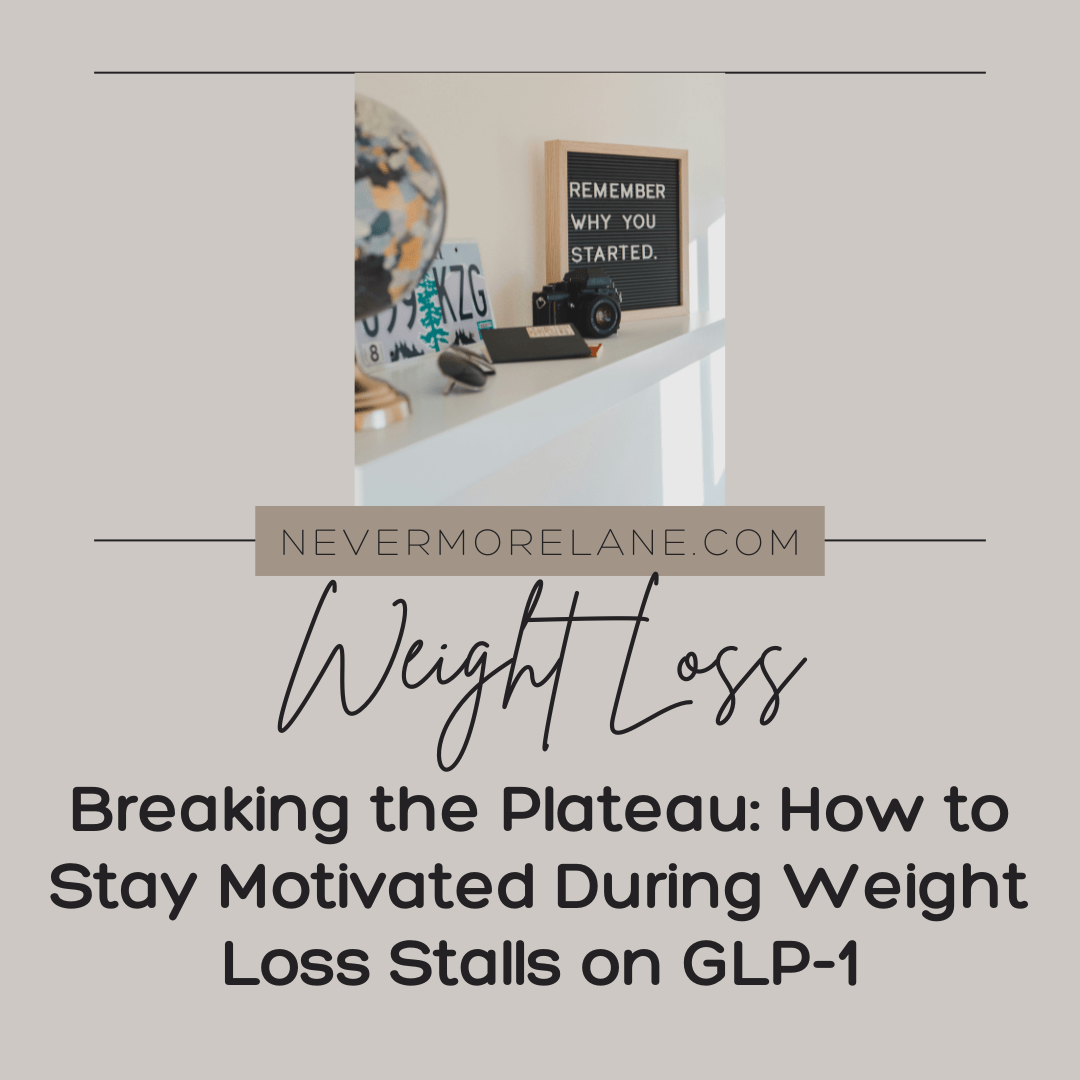The GLP-1 Grocery Guide: A 5-4-3-2-1 Plan for Protein, Fiber, and Thriving
Starting a GLP-1 medication like Ozempic, Wegovy, Mounjaro, or Zepbound changes everything about how you eat. Suddenly, the appetite that used to drive you to the kitchen has vanished. Food that once seemed appealing now feels completely unnecessary or even unappealing. You might go hours without thinking about eating, only to realize at 8 PM that you’ve consumed maybe 400 calories all day. While the appetite suppression is exactly what these medications are designed to do, it creates a new challenge. How do you ensure you’re getting adequate protein to preserve muscle mass, enough fiber to keep your digestion functioning, and sufficient hydration when you have zero interest in food or drink? The grocery store becomes a confusing place when your body isn’t sending the usual hunger signals to guide your choices.
I started my GLP-1 journey last year and those first few shopping trips were genuinely bewildering. I’d wander the aisles feeling completely disconnected from food, unable to imagine actually eating anything I saw. My cart would end up with random items that seemed theoretically nutritious but that I had no real plan for using. Meanwhile, I was reading on Reddit and in Facebook groups the consequences of not eating enough protein. My hair was already thinning thanks to perimenopause, my energy was low, and my doctor gently but firmly told me I had to continue working out to not lose my muscle mass.
I started to struggle to drink enough water because I simply forgot, leading to headaches and fatigue. I needed a system that would ensure I got the nutrients my body desperately needed even when my appetite was giving me absolutely no guidance. That’s when I adapted the 5-4-3-2-1 method specifically for GLP-1 users, prioritizing the three things we need most: protein, fiber, and hydration.
Today, I’m sharing this specialized grocery framework that has transformed my GLP-1 experience. This isn’t the standard 5-4-3-2-1 method. It’s been carefully modified to address the unique nutritional challenges that come with appetite suppressing medications. This plan ensures you’re getting enough high quality protein to preserve muscle, adequate fiber to support digestive health, and strategic hydration support when drinking water feels like a chore. Whether you’re just starting your GLP-1 journey or you’ve been on these medications for months, this grocery guide will help you shop with intention and nourish your body properly even when food holds zero appeal.
The Modified 5-4-3-2-1 Framework for GLP-1 Users
The GLP-1 specific version of this method looks different from standard grocery planning because our nutritional priorities are different. We’re not just trying to eat a balanced diet. We’re actively working to preserve muscle mass during rapid weight loss, support a digestive system that’s moving more slowly than usual, and stay hydrated when we have no natural thirst signals. My framework focuses intensely on these three critical areas while keeping shopping simple and manageable.
Here’s what goes in your basket: five high fiber vegetables that pack maximum nutrition into small volumes, four hydrating fruits that provide both water content and fiber, three premium protein sources that deliver the most protein per bite, two fiber rich complex carbohydrates that support digestive health, and one hydration enhancer that makes drinking water more appealing. This ratio ensures you’re getting at least 80 to 100 grams of protein daily, 25 to 30 grams of fiber, and support for drinking your target water intake even when you have zero desire to eat or drink anything.
The beauty of this modified framework is that it acknowledges your reality. You’re not going to eat large volumes of food. Your appetite is suppressed, and that’s actually the point of your medication. So instead of fighting against that or buying groceries as if you still have a normal appetite, this method works with your reduced capacity. Every item in your basket is chosen for its nutrient density and its ability to deliver maximum nutrition in minimal volume. You’re not buying foods you’ll force yourself to choke down. You’re selecting items that are easier to consume when you’re not hungry and that pack the specific nutrients your body needs most right now.
Your Five High Fiber, Nutrient Dense Vegetables
For my vegetable selections, I prioritize options that deliver substantial fiber and micronutrients in small servings. Spinach is always in my basket because it cooks down dramatically, making it easy to consume a large amount in a small volume. I add it to eggs, blend it into smoothies, or sauté it as a side dish. Just one cup of cooked spinach provides nearly 5 grams of fiber plus iron, calcium, and vitamins A and K. When I’m eating tiny portions, these nutrient dense choices become crucial for preventing deficiencies.
Broccoli is another non-negotiable for me. It’s high in fiber, provides protein for a vegetable, and is incredibly versatile. I roast it until it’s crispy, steam it and blend it into soups, or eat it raw with hummus when I can manage the crunch. The fiber content helps with the digestive sluggishness that many of us experience on GLP-1 medications. Brussels sprouts are similar in that they’re fiber powerhouses that can be prepared in ways that make them more appealing when you’re not particularly hungry. Roasted until caramelized, they’re easier to eat than you’d expect.
My fourth vegetable is usually bell peppers because they’re hydrating, provide vitamin C, and add color and crunch to meals without being heavy. I dice them small and add them to scrambled eggs or eat them sliced with protein rich dips. For my fifth vegetable, I rotate based on what’s available, often choosing cauliflower for its versatility. I can rice it as a low volume carbohydrate substitute, roast it, or blend it into creamy soups that are easier to consume when solid food feels like too much. Asparagus is another excellent choice when it’s in season, providing fiber and folate in a vegetable that feels light and elegant rather than heavy.
The key with vegetable selection for GLP-1 users is choosing options you can prepare in multiple ways to match how you’re feeling on any given day. Some days, you might be able to handle raw vegetables with dip. Other days, everything needs to be cooked until soft and blended into soup. These five vegetables work across that entire spectrum, ensuring you can get your fiber and micronutrients regardless of how your digestion is cooperating.
Four Hydrating, Fiber Rich Fruits
Fruit selection for GLP-1 users requires strategic thinking because we need the hydration and fiber but often can’t manage large quantities. Berries are my absolute top choice, and I always have them in my basket. Strawberries, blueberries, raspberries, and blackberries are all high in fiber relative to their volume, pack antioxidants, and have high water content. I eat them plain when I can, blend them into protein smoothies, or top them on Greek yogurt. A cup of raspberries delivers 8 grams of fiber, which is remarkable.
Watermelon is my second fruit staple because it’s literally designed by nature to deliver hydration. It’s over 90 percent water while still providing vitamins and a small amount of fiber. When drinking water feels impossible, eating watermelon counts toward my hydration goals. I cut it into small cubes and keep them in the fridge for easy access. On days when I’m struggling to drink enough, snacking on watermelon throughout the day makes a significant difference in how I feel.
Oranges or clementines claim my third fruit spot for their hydration content, fiber, and vitamin C. The segments are easy to eat in small amounts, and the natural sweetness is often one of the few flavors that still appeals when the medication has dulled my taste sensations. I peel and segment them in advance, storing them in containers so they’re grab and go when I remember I should probably eat something. The fiber in the segments also helps with digestive motility.
My fourth fruit varies seasonally but often lands on apples because they’re high in soluble fiber, which is particularly helpful for the digestive challenges common with GLP-1 medications. I eat them with nut butter to add protein, or I cook them down into unsweetened applesauce that’s easier to consume when whole foods feel like too much texture. Pears are similar in their fiber content and work beautifully when roasted until soft for days when eating feels difficult.
I do try to enjoy half of a banana too due to its nutritional properties.
Three Premium, Easily Digestible Proteins
Protein is absolutely critical on GLP-1 medications, and this is where I’m most careful about my selections. I’m aiming for 80 to 100 grams of protein daily even though I’m eating maybe 1000 to 1200 calories total. That means every protein choice needs to be incredibly efficient. Greek yogurt is always in my basket because it delivers 15 to 20 grams of protein per serving in a form that’s easy to eat even when I have no appetite. I choose the plain, full fat version and add berries or a small amount of honey. The probiotic content also supports digestive health.
Eggs are my second protein staple because they’re versatile, affordable, and pack 6 grams of protein each along with essential nutrients. I hard boil a dozen at the start of the week for quick protein hits throughout the day. I scramble them with vegetables for a protein rich breakfast that doesn’t require much appetite to consume. The fat content helps with satiety in the small amounts I’m eating, and they’re one of the most bioavailable protein sources available.
For my third protein, I rotate between chicken breast, white fish, and extra lean ground turkey or pork depending on what sounds remotely appealing that week. I choose lean options because many GLP-1 users develop an aversion to fatty meats. The medications slow gastric emptying, which means fatty proteins can sit heavily and uncomfortably. Chicken breast is easy to dice small and add to soups or salads. White fish like cod or tilapia is incredibly mild and easy to digest. Ground turkey makes protein rich additions to vegetables or can be formed into small meatballs that are easier to eat than a large piece of meat.
I also keep protein powder on hand as a backup, though I don’t count it as one of my three basket proteins since it’s more of an insurance policy. On days when eating solid food feels impossible, I can blend protein powder with almond milk, spinach, and berries into a smoothie that delivers 30 grams of protein in a drinkable form. This ensures I’m hitting my protein targets even on the most difficult days.
Two Fiber Rich, Digestive Supporting Carbohydrates
Carbohydrate selection on GLP-1 medications requires thoughtfulness because we need the fiber for digestive health but often struggle with volume. My first choice is almost always quinoa because it’s technically a complete protein while also providing substantial fiber. One cup of cooked quinoa delivers 8 grams of protein and 5 grams of fiber. It’s light, doesn’t sit heavily, and can be served warm or cold. I make a batch at the beginning of the week and use it as a base for vegetables and protein throughout the week.
My second carbohydrate choice usually lands on legumes like lentils or black beans. They’re fiber powerhouses that also contribute significant protein. One cup of cooked lentils provides 18 grams of protein and 16 grams of fiber, which is remarkable for a single food. I make lentil soup that I can sip when solid food feels like too much, or I add small amounts of black beans to eggs or on top of salads. The fiber content is crucial for maintaining digestive regularity when the medication is slowing everything down.
I specifically avoid white bread, white rice, and other refined carbohydrates now, not because they’re inherently bad but because I have such limited eating capacity that every bite needs to count. When I can only eat small amounts, choosing fiber rich complex carbohydrates over refined options makes a significant difference in my overall nutrition and digestive health. The fiber helps prevent the constipation that’s common with GLP-1 medications while also helping me feel satisfied with smaller portions.
One Strategic Hydration Enhancer
This is perhaps the most important category for GLP-1 users because adequate hydration is one of our biggest challenges. The appetite suppression often extends to thirst signals, and many of us simply forget to drink water. My hydration enhancer changes based on what I need that particular week, but the goal is always the same: make water consumption more appealing and trackable.
Sometimes my hydration enhancer is a packet of sugar free water flavor enhancer. These add flavor to water without sugar, provide essential minerals that support hydration, and make drinking water feel less like a chore. I mix a packet into my water bottle in the morning and sip it throughout the day, knowing I’m getting both hydration and essential nutrients.
Other weeks, my enhancer might be herbal tea bags. Having a variety of flavors makes drinking fluids more interesting when plain water feels boring. Hot tea also takes longer to drink, which helps me consume more total fluid since I’m forced to sip slowly. Green tea adds antioxidants, while ginger tea can help settle the occasional nausea that some people experience with GLP-1 medications.
Occasionally, my hydration enhancer is fresh lemons or limes for infusing water. The subtle flavor makes water more appealing without adding calories, and it gives me something to do with my hands when everyone else is eating and I’m trying to at least drink something to participate in the meal socially. The ritual of slicing citrus and adding it to water makes hydration feel more intentional rather than just another thing I’m forgetting to do.
The Reality of Shopping and Eating on GLP-1 Medications
I want to be honest about what grocery shopping and meal planning look like when you’re on these medications. Some days, you’ll go to the store and feel absolutely nothing looking at food. Items that used to be your favorites will seem completely unappealing. This is normal and expected. The key is shopping from a list based on nutritional needs rather than shopping based on appetite or cravings, because those signals are no longer reliable guides.
I shop when I’ve recently taken my medication dose and my appetite suppression is strongest. This might seem counterintuitive, but I’ve found that shopping when I’m not hungry prevents impulse purchases of foods that sound good in the moment but that I won’t actually eat. I stick to my 5-4-3-2-1 list religiously because I know these items will deliver the nutrition I need even if they don’t sound particularly exciting. I’m not shopping for pleasure anymore. I’m shopping for fuel and function.
Meal prep becomes essential in a way it never was before. On days when I have slightly more energy and appetite, I prepare multiple servings of proteins and grains. I hard boil eggs, cook chicken breast, prepare quinoa, and wash and cut vegetables. These prepared items live in clear containers in my fridge where I can see them. When eating feels like a chore, having food that’s ready to eat removes one more barrier. I can grab a hard boiled egg and some berries without having to cook or prepare anything, making it more likely I’ll actually consume the protein I need.
I track my protein intake religiously using an app because I cannot rely on appetite or fullness cues to guide my eating. I aim for 80 to 100 grams daily, and I front load my protein earlier in the day when I tend to have slightly more capacity for eating. Breakfast might be Greek yogurt with berries and a scoop of protein powder blended in. Mid morning, I eat two hard boiled eggs. Lunch is a small portion of chicken with vegetables. By dinner, I’ve already hit most of my protein target, which takes pressure off the evening meal when appetite suppression is often strongest.
Addressing the Challenges Head On
The digestive effects of GLP-1 medications are real and significant. The slowed gastric emptying that makes us feel full is also responsible for the occasional nausea, bloating, and constipation many users experience. This is exactly why the fiber focus in this grocery framework is so crucial. The vegetables, fruits, and fiber rich carbohydrates help keep your digestive system moving even when the medication is slowing everything down. I aim for 25 to 30 grams of fiber daily, and I increase my intake gradually if I’m experiencing constipation.
Hydration cannot be overstated in its importance. The medication doesn’t just suppress hunger. For many of us, it also diminishes thirst signals. I set alarms on my phone every two hours reminding me to drink 8 ounces of water. This sounds excessive, but without these reminders, I would go entire days drinking maybe 20 ounces total. The headaches, fatigue, and constipation that result from dehydration make everything worse. The hydration enhancer in my basket is what makes this sustainable because it transforms water from a boring obligation into something I actually want to consume.
The protein focus protects against muscle loss, which is a serious concern during rapid weight loss. Studies show that people losing weight on GLP-1 medications can lose significant lean muscle mass along with fat if they’re not intentionally consuming adequate protein and doing resistance exercise. This is why my framework prioritizes protein above almost everything else. I’d rather eat less of other things and hit my protein target than eat a more “balanced” diet that leaves me protein deficient and losing muscle. The premium proteins in my basket deliver maximum protein in minimum volume, making it possible to hit those targets even with dramatically reduced appetite.
Your Path Forward
The GLP-1 grocery framework offers a practical approach to a challenge that many doctors don’t adequately address. They prescribe these life changing medications but often provide minimal nutritional guidance beyond “eat less and eat healthy.” That’s not enough when your appetite has vanished and you’re at risk for significant nutrient deficiencies and muscle loss. This 5-4-3-2-1 plan prioritizes exactly what your body needs most: protein to preserve muscle, fiber to support digestion, and hydration to prevent the complications of inadequate fluid intake.
This method transforms grocery shopping from an overwhelming task into a straightforward process with clear parameters. You know exactly what belongs in your basket. You’re not wandering the store feeling disconnected from food and randomly grabbing items that seem theoretically healthy. You’re shopping with intention, selecting specific items that address your specific nutritional needs as a GLP-1 user. The framework is flexible enough to accommodate your preferences while maintaining the nutritional priorities that keep you healthy during this significant medical intervention.
Most importantly, this approach acknowledges that you’re navigating something genuinely difficult. Yes, the weight loss is often dramatic and positive. Yes, these medications are incredibly effective. But managing adequate nutrition when you have no appetite is a real challenge that deserves real strategies. This framework is designed specifically for that challenge, for the days when food holds zero appeal but your body still needs protein and fiber and water. It’s designed for the reality of living on GLP-1 medications, not for some idealized version of healthy eating that doesn’t account for appetite suppression.
If you’re on this GLP-1 journey, I’m here walking alongside you. Nevermore Lane is dedicated to creating magic in everyday life, and sometimes that magic looks like figuring out how to nourish yourself when food has lost its appeal. I share more strategies for thriving on these medications, managing the mental and emotional aspects of rapid weight change, and creating a life that feels both intentional and joyful throughout this transformation. Browse my other posts on mindful eating, body acceptance during weight loss, and finding your own path through this experience.
And please, join me for coffee. Or tea. Or just water with a squeeze of lemon, because hydration is everything right now. Subscribe to the Nevermore Lane newsletter where I share honest conversations about the realities of GLP-1 medications, the challenges nobody mentions, and the strategies that actually work. This community understands that weight loss is complicated, that these medications are tools not magic solutions, and that we’re all figuring this out together. I’d love to have you as part of this conversation. Your place at the table is ready, and I promise there’s no pressure to actually eat anything.
Like what you read? Drop me a line – let’s chat over virtual coffee.
~ Chrystal




